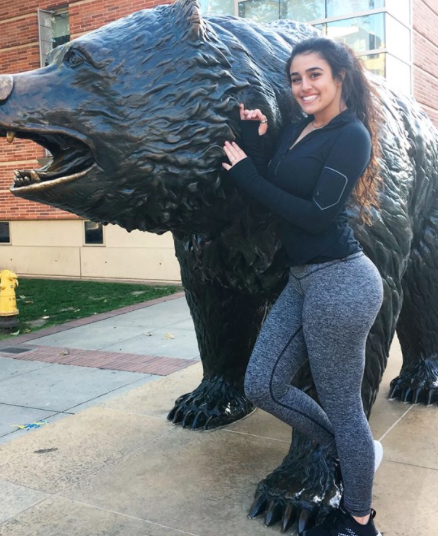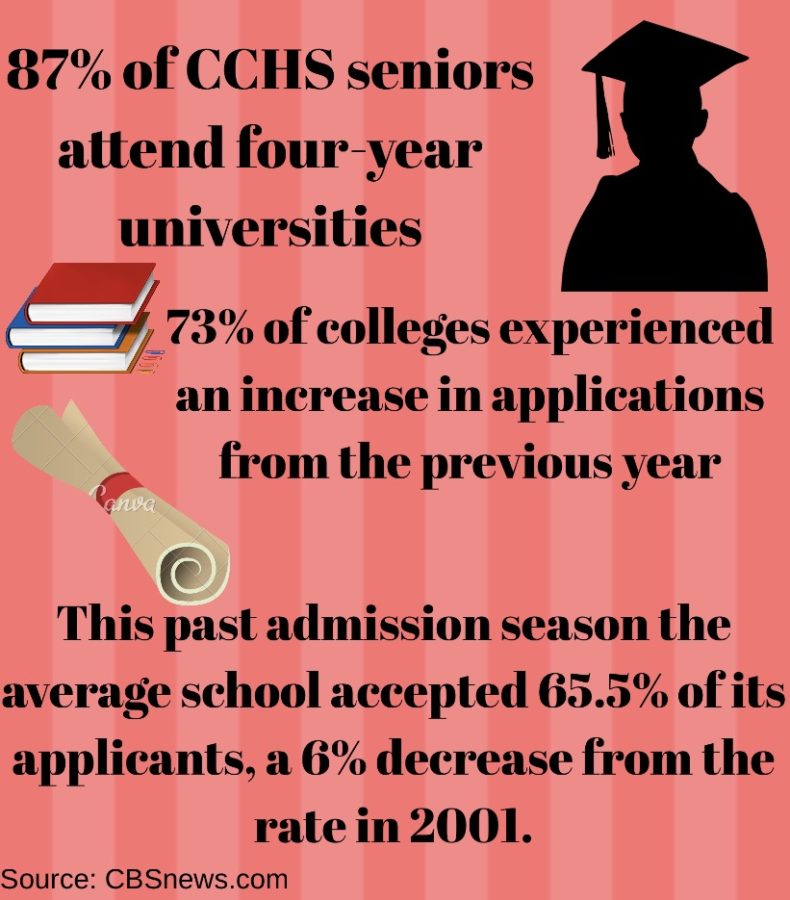Rejection awaits for best, brightest, and brainy
Mater Dei Catholic High School alumna Sophie Baldarrema ’15, who maintained a 4.5 GPA in high school, served as a club president, and competed on the school’s swim team, applied for a spot at Columbia University. Despite a perfect SAT score and stellar letters of recommendation, Baldarrema was declined.
Her dreams were crushed.
“It was one of the hardest moments I’ve had to deal with, mainly because for four years I dedicated so much time and effort, and still got rejected,” Baldarrema, now a junior at USC, said. “Even though I love the university where I ended up, I know what millions of students feel like, especially after a year like the one we just saw for college admissions.”
Baldarrema’s story is not unique.
This past college acceptance season has witnessed a spike in increased competition for limited seats at U.S. colleges and universities, resulting in increased rejections notices being received by otherwise highly qualified applicants.
For example, The Daily Pennsylvanian reports that in 2017, the acceptance rate for Columbia’s class of 2021 was at 5.5 percent as compared to the 6.9 percent for the class of 2015. Moreover, Stanford University’s acceptance rate was a 15.5 percent in the year 2001, but today Stanford’s acceptance rate is at 4.7 percent.
Stanford’s decrease in acceptance rate exists as an accurate model of other Ivy and Division I colleges throughout the U.S.
In regards to college admissions, 2017 is proof that with each year that passes, admissions become more competitive, causing millions of U.S. students excessive stress and disillusionment.
Millions of students dedicate themselves and diligently strive to attain the perfect GPA, while also balancing extracurriculars during a four-year period, only to be rejected for a spot at elite universities.
Every year approximately 3.3 million students graduate high school, and about 66 percent of them enroll immediately in college. Despite sounding fairly reasonable, some of the most elite universities reject up to 95 percent of the best, brightest, and brainy students, according to National Center for Education Statistics.
And each year gaining acceptance gets even more difficult.
Students who applied to colleges in 2017 for a place in Fall of 2018 realized the odds were not in their favor as last year was the most selective year students have endured so far regarding college admissions.
Mrs. Jessica Saenz-Gonzalez, the owner of the San Diego Learning Center, offered SAT and ACT prep to students for the past decade, and she noticed how selective universities have become.
“Over the years, I have definitely seen colleges become more selective and way more competitive,” Mrs. Saenz-Gonzalez said. “Sometimes it doesn’t matter how smart you are, or how many clubs you are in. Sometimes it just comes down to what the universities need to keep the diversity balanced.”
A huge factor regarding the difficulty and competitiveness for college admission is based on what the universities need.
For example, one year institutions of higher learning might need more females than males to adjust their gender ratios. Or sometimes, colleges and universities might need to increase their international numbers, giving foreign students priority that year as compared to native students.
“It really depends on what the university needs,” Mrs. Saenz-Gonzalez said.
The problem is much more complex because it features two unique sides.
On the positive side, double the amount of U.S. students want to pursue higher education. However, because of this desire, more students apply each year, thus adding more pressure and competition.
“I think the main difference I see between students who apply to college today, and what I went through when I applied to college, is the number of students who apply,” CCHS college counselor Ms. Kristen Micho said. “Every year the number of applicants grow, but the number of seats available for most colleges aren’t keeping up with this growth. Colleges want to see more than GPA and test scores.
“Along with the rigor of their courses, colleges want to see how a student is challenging themselves in order to reach their best potential.”
When the admission officers admit students, they evaluate GPA, test scores, and course rigor. In the end, colleges want to see the degree to which a student challenges himself or herself to reach his or her potential.
Despite sounding extremely daunting, competition among colleges and universities always has existed. However, with more than 4,000 colleges and universities available to students, more options exist other than their dream schools.
“Even though I didn’t end up getting into my dream school, I’m so happy to be at USC,” Balderrema said. “It ended up being the perfect fit for me.”
From ‘Our House’ to dorm house

Annalise Gazale ‘18 poses at the University of California, Los Angeles, on a visit where her and her family decided she would attend the school this fall.
For Cathedral Catholic High School student Annelise Gazale ‘18, the University of California, Los Angeles ranks as her dream institution of higher learning.
“My application process was very stressful because I knew my entire future would depend on what I wrote,” Gazale said. “I made sure that my application covered everything about me since the only other thing they would see were my grades and test scores.
“Therefore, I chose to answer questions that would show who I was and highlight my best qualities.”
With competition increasing for admittance into U.S. colleges and universities, gaining acceptance to prestige institutions such as UCLA can seem impossible for many seniors. For the last several years, competition among college admissions has skyrocketed all across America, forcing high school seniors to employ extreme measure to overcome increasingly low acceptance rates.
And CCHS students, like Gazale, are not immune from this predicament.
Thankfully, thanks to Gazale’s hard work and support from her family and academic counselors, she will attend UCLA this fall as a pre-med student.
CCHS Dean of Counseling Mrs. Ashley Bascom understands the stressful situation students find themselves facing only all too well.
“Let’s say you apply to 40 different schools, and [you] get accepted to 30,” Mrs. Bascom said. “You are being given 30 different spots, but will only end up filling one. This leaves the other 29 spots unoccupied, but unavailable to other students.
“Basically, the competitiveness is so high because the number of applications is growing, as well.”
Although thousands of seniors work long hours to perfect their applications, CCHS students enjoy one small advantage.
“Many colleges look at students in the context of their schools, which is why we send out the school profile on our website,” college counselor Mrs. Felicia Young said. “That way they are aware of the rigor of CCHS, and they also look at CCHS students in the context of other CCHS students [who] apply.”
While CCHS maintains a strong reputation as a college preparatory high school, the common anxiety that accompanies the college application process still exists.
The CCHS counseling department recommends that students apply to no more than 12 colleges, especially considering applications can cost upward of $100. Moreover, the entire college application process can cover many months filled with sending letters of recommendation, test scores, essays, and grades to selected colleges and universities.
“I always knew that UCLA was the most ideal school for me in every aspect, but I knew it would be a reach and very difficult to get into to,” Gazale said. “So, I didn’t limit myself to where I applied.”
Gazale’s limitless attitude can be a saving grace in many cases, and the CCHS counseling department even recommends the majority of colleges a student will apply to should be “good bet schools.”
“We call them ‘good bet schools’ instead of safety schools because of the competitiveness,” CCHS college counselor Ms. Kristen Micho said. “There’s no guarantee a student will get in, but these schools are ones where the student is above the average GPA and test score.”
There remains the notorious stress when it comes to college acceptance rates, but approximately 87 percent of CCHS students who graduate will attend four-year universities. A majority of the remaining students do get accepted into four-year universities, but choose to pursue a different path after graduation, according to Ms. Micho.
Popular four-year choices among CCHS seniors are UC and CSU schools, such as UCLA or California Polytechnic State University. Being close to home while receiving a four-year education, California schools offer many opportunities to young students, and Gazale is just one of the many students excited to begin next fall.
While many students will join Gazale at UCLA this September, the school is the most applied to university in the U.S. From the CCHS graduating class of 2017, approximately 98 seniors applied to UCLA. Eighteen were accepted and 10 enrolled. The average GPA of accepted students at UCLA stands at 4.27, while their average ACT is 32, according to Naviance, a comprehensive college and career readiness website.
Gazale’s accomplishment proves that the college admissions process may be long, but with the right amount of motivation and support, any school can become a possibility.
“Work your butt off,” Gazale said. “Push yourself in the classes you choose to take, and know that the application process is no joke.”
